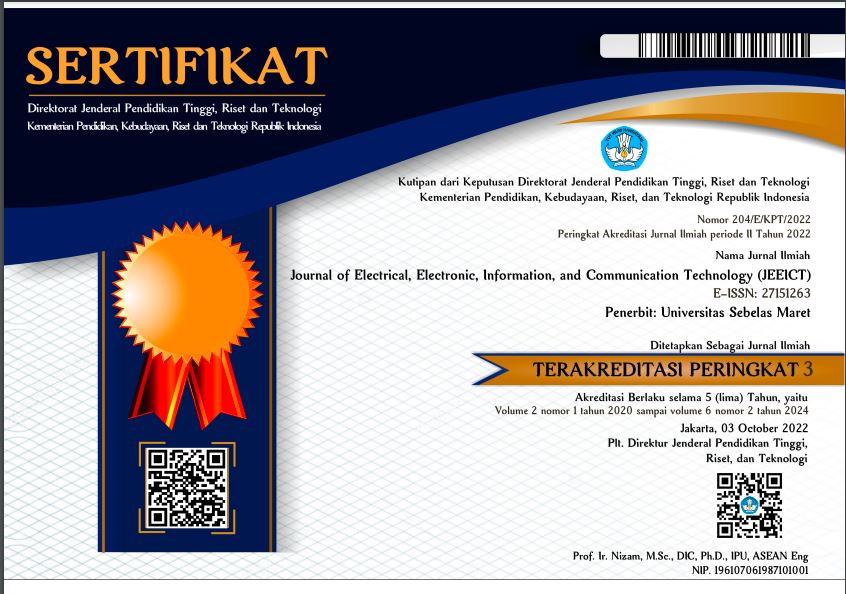Unit Commitment-Security Constraints Using the Priority List-Genetic Algorithm Method in the IEEE 6 Bus and IEEE 14 BUS Case Studies
Abstract
Unit commitment (UC) is the scheduling of on-off operation of a power plant unit to meet the demand for electrical power over a certain period of time in order to obtain an economical total cost of generation The PL method is used for scheduling and the AG is optimized using DOE for ED problems. The results obtained from the research that there are still improvements in the calculation of ED problems using load flow constraints and can be corrected. The results of the comparison of the total percentage cost of IEEE 6 buses used in ED problems without considering the load flow constraints with those considering this problem amounted to 26.30%. The result of the comparison of the total percentage cost of IEEE 14 buses used in ED problems without considering load flow constraints with those considering this problem is 11.55%. The load flow calculation using Newton-Rapshon uses a smaller number of iterations and a shorter time than Gauss-Seidel.
Full Text:
PDFReferences
Wood, A.J. & Wollenberg, B.F., 1996. Power Generation, Operation, and Control, Second Edition. New York: John Willey & Sons.
Chefai Dhifaoui, Ismail Marouani, Hsan Hadj Abdallah, “Unit Commitment Problem with Wind and Solar Energy Considering Emission Reduction using Dynamic Programming”, International Journal of Advanced Science and Technology, 2020. 29(05), pp. 4152 - 4162.
Christiansen, J.C..D.C.A..&.B.J.P., “An Approach to Solve the Unit Commitment Problem Using Genetic Algorithm”. In IEEE Power Engineering Society Summer Meeting, 2000.
Padhy, N.P., “Unit Commitment-A bibliographical survey”. IEEE Transactions on Power Systems, 2004. 19(2), pp.1196 - 1205.
Tingfang, Y. & Ting, T.O., “Methodological Priority List for Unit Commitment Problem”. International Conference on Computer Science and Software Engineering, 2008. 1, pp.176-79.
Dasgupta, D. & McGregor, D.R., “Thermal unit commitment using genetic algorithms. IEE Proceedings-Generation”, Transmission and Distribution, 1994. 141(5), pp.459 - 465.
Momoh, J.A., 2001. Electric Power System Applications of Optimization. New York: Marcel Dekker, Inc.
Adiwena Danar, dkk. “Unit Commitment Mempertimbangkan Stabilitas Tegangan dengan Metode Binary Particle Swarm Optimization (BPSO)”, Jurusan Teknik Elektro, Institut Sepuluh Nopember, Surabaya, pp. 289-294, 2016.
Budi Mulyawan Arief, “Unit Commitment Menggunakan Metode Hibrid Priority List dan Algoritma Genetika Dengan Mempertimbangkan Load Flow Constraints”, Skripsi Universitas Gajahmada, 2013.
Sarijaya, P. Hadi Sasongko, Rizki W. Daniar. “Unit Commitment dengan Kekangan Keandalan Menggunakan Algoritme Genetika Mempertimbangkan Ketidakpastian Beban”, pp. 341-347, 2016. F. N. Budiman, Sarjiya, dan M. Isnaeni, “Penjadwalan Unit Pembangkit Termal dengan Memperhitungkan Kekangan Emisi Lingkungan dan Ketidakpastian Sistem”, Skripsi Universitas Gadjah Mada, 2009.
J. H. Van Sickel, K. Y. Lee, and J. S. Heo, “Differential Evolotion and Its Appliacations to Power Plant Control,” International Conference on Intellegent Systems Aplications to Power Systems , no. 2, pp. 560-565, 2007.
P. Kundur, J. Paserba, V. Ajjarapu, G. Andersson, A. Bose, C. Canizares, N. Hatziargyriou, D. Hill, A. Stankovic, C. Taylor, T. Van Cutsem, and V. Vittal, “Definition and classification of power system stability”, IEEE Trans. on Power Syst., Vol. 19, No. 4, 2004, pp. 1387-1401.
Capitanescu Florin, “Assessing Reactive Power Reserves with Respect to Operating Constraints and Voltage Stability”, University of Liedge, 2003.
Sarjiya, A. B. Mulyawan and A. Sudiarso, "Optimal solution of reliability constrained unit commitment using hybrid genetic algorithm-priority list method,” 2014 6th International Conference on Information Technology and Electrical Engineering (ICITEE), Yogyakarta, Indonesia, 2014, pp. 1-6.
Refbacks
- There are currently no refbacks.







